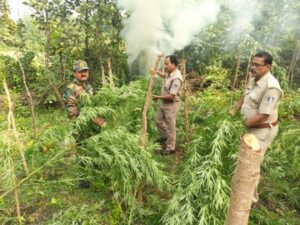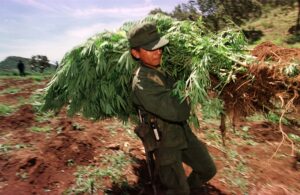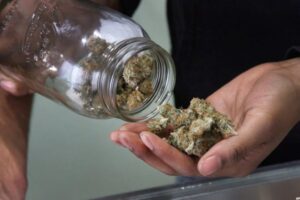Here’s the dope on a big business: Nearly 1,000 villages devote 10,000 acres to a plant used to make a product that commands a price of Rs 40,000 per kg in major urban markets. The plant is cannabis or Ganja. The place is Paderu in Andhra Pradesh, the centre of eight mandals that cultivate the plant. Tune in as #KhabarLive takes you inside the cannabis capital of India.
 A tribal belt about 100 km north of Visakhapatnam. The area is administered by the Integrated Tribal Development Agency (ITDA), headquartered in Paderu, which is one of the eight mandals (or tehsils) where cannabis cultivation has become a challenge for the state administration. The others are Hukumpeta, Gmadugula, Pedabhayalu, Munchangiputtu, Dumbriguda, Chinthapalli and GK Veedhi.
A tribal belt about 100 km north of Visakhapatnam. The area is administered by the Integrated Tribal Development Agency (ITDA), headquartered in Paderu, which is one of the eight mandals (or tehsils) where cannabis cultivation has become a challenge for the state administration. The others are Hukumpeta, Gmadugula, Pedabhayalu, Munchangiputtu, Dumbriguda, Chinthapalli and GK Veedhi.
The eight mandals have a population of 4.43 lakh, according to 2011 Census, with 90% of the people being tribals. Paderu is the main town in the area and the cannabis produced in the entire belt is popularly called Paderu ganja.
How becomes ‘Ganja Capital’ of India?
This region is quickly becoming the cannabis capital of India, say officials. While cannabis is grown in several parts of the country, this region and the neighbouring Malkangiri district of Odisha has seen a spurt in cultivation. In the eight mandals, the area under cannabis cultivation is estimated to be 10,000 acres spread across 1,000 (of the total 3,000) villages, according to data available with the office of deputy commissioner of prohibition and excise (enforcement) of Visakhapatnam district. One acre of cannabis fetches Rs 2 lakh, making the market size of the Paderu cannabis at the source Rs 200 crore.
The crop season for cannabis in this hilly part of northeastern Andhra Pradesh starts in September. The crops are ready for plucking and processing by December-January. Aware of this, the authorities are stepping up their fight against the cultivation. “Last year, we used drones to help us destroy cannabis cultivation,” says SVVN Babji Rao, deputy commissioner of prohibition and excise (enforcement) of the district of Visakhapatnam. “This year, we will go in further and also use mechanised cutters. The problem is mounting as more local people have turned agents now.”
 Authorities raided 249 villages since the last season (September-January) to crack down on cannabis cultivation. Between September 15, 2017, and January 31, 2018, an estimated 1.7 crore cannabis plants spread across 3,122 acres in the belt were destroyed.
Authorities raided 249 villages since the last season (September-January) to crack down on cannabis cultivation. Between September 15, 2017, and January 31, 2018, an estimated 1.7 crore cannabis plants spread across 3,122 acres in the belt were destroyed.
Modus operandi
But this is not an easy task. The Rs 2 lakh an acre that villagers earn by cultivating cannabis is double that of the earning from a conventional crop like turmeric. Sometimes, drug agents pay farmers the cultivation cost. They occasionally supply fertilisers to enhance production. The agents also advise the villagers on what varieties to grow. A chain of agents — both locals and those belonging to Tamil Nadu and Kerala — ensures the illicit cannabis trade in Paderu stays alive. Villagers pluck and process the plants and hand over the produce to the agents, who take the responsibility of smuggling the substance out of the ITDA area.
Agents use various methods. Labourers are engaged to carry loads on their heads to motorable tracks, from where two-wheelers and three-wheelers are used. Agents also use vehicles with hidden chambers to get past law-enforcers.
The Paderu belt cultivates three varieties of cannabis — Raja Hamsa, Kala Pathri and Seelavathi, the last being the most popular one. The Seelavathi variety has high demand in Tamil Nadu, Kerala, Karnataka, Maharashtra, Uttar Pradesh, Delhi and Haryana, according to Superintendent of Police of Visakhapatnam district (rural), Rahul Dev Sharma. “Ganja smugglers are getting smarter each passing day. They are using vehicles like oil and water tankers and even ambulances. They have even formed WhatsApp groups with the villagers to avoid making phone calls (and getting caught),” says Sharma.
In addition to the Andhra cannabis belt, supplies come from Nepal-UP, Bihar-Delhi and Jammu and Kashmir-Goa belts. The crackdown has yielded some results. Seizure of cannabis across the country has gone up significantly in the past five years. In 2017, 3.5 lakh kg of cannabis were seized, up from only 91,792 kg in 2013, according to the Narcotics Control Bureau (NCB).
Other processed drugs
 But cannabis is not the only drug causing a headache to the government. Hashish or charas — a drug processed out of cannabis — is another problem. The seizure of hashish across the country has, however, declined from 4,407 kg in 2013 to 3,218 kg in 2017. The roots of hashish supply are in the districts of south Kashmir and Kullu in Himachal Pradesh, according to the NCB. The major destination are Maharashtra, Rajasthan, Delhi, Goa and Gujarat. According to information with the NCB, 2017 saw major seizures across the country — Kolkata, Chandigarh, Ahmedabad, along the Agra-Delhi Yamuna Expressway and in the port of Thoothukudi.
But cannabis is not the only drug causing a headache to the government. Hashish or charas — a drug processed out of cannabis — is another problem. The seizure of hashish across the country has, however, declined from 4,407 kg in 2013 to 3,218 kg in 2017. The roots of hashish supply are in the districts of south Kashmir and Kullu in Himachal Pradesh, according to the NCB. The major destination are Maharashtra, Rajasthan, Delhi, Goa and Gujarat. According to information with the NCB, 2017 saw major seizures across the country — Kolkata, Chandigarh, Ahmedabad, along the Agra-Delhi Yamuna Expressway and in the port of Thoothukudi.
On the other hand, the trafficking of opium, morphine, heroin and cocaine has been on the rise in the recent years. The number of seizures of illicit opium, for example, increased from 881 in 2013 to 1,408 in 2017. However, the seized quantity remained almost the same — 2,333 kg in 2013 against 2,551 kg in 2017. In fact, Rajasthan (427 kg) and Punjab (507 kg) saw the highest seizures of opium in 2017, according to government data. Unlike cannabis cultivation, which is illegal under the Narcotic Drugs and Psychotropic Substances Act, 1985, a part of the opium cultivation is legal and licensed. In 2017-18, legal opium poppy cultivation was taken up in 24 districts across Maharashtra, Uttar Pradesh and Rajasthan.
Another drug problem that India is battling is heroin. Internal security issues make this issue of heroin trafficking even more serious as a lot of the substance flows in through porous international borders. Despite constant vigil, heroin continues to come in via the Pakistan border, mainly into Punjab and Jammu and Kashmir. India’s long coastline also gives smugglers ample opportunity to land undetected. The seizure of 1,017 kg of heroin and 426 kg of morphine (heroin is a refined version of morphine and hence is costlier) from a vessel off the Gujarat coast in July 2017 is still one of the most talked about incidents in the narcotics circle. NCB investigations had revealed the kingpin was an Iranian national. The drugs were loaded near Pakistan’s Gwadar port with the help of a speedboat.
Narcotics Smuggling
So far as heroin is concerned, India is more a transit country than a consuming nation. Narcotic officials say heroin trafficking through air is often caught, mainly in the stretch between Kabul and New Delhi. The bulk of the trafficking still happens through the India-Pakistan border. Maritime trafficking of heroin is relatively a new trend, they say.
 Another powerful addictive stimulant is cocaine. This substance, too, is largely trafficked into India, mostly from West African nations and in small quantities from Argentina and Brazil. The total cocaine seizure in 2017 was 69 kg, as against 47 kg in 2013. Seizures mostly happen at airports. NCB data show that it is often concealed in household items bought in via flights, such as books, utensils, cosmetics and food items.
Another powerful addictive stimulant is cocaine. This substance, too, is largely trafficked into India, mostly from West African nations and in small quantities from Argentina and Brazil. The total cocaine seizure in 2017 was 69 kg, as against 47 kg in 2013. Seizures mostly happen at airports. NCB data show that it is often concealed in household items bought in via flights, such as books, utensils, cosmetics and food items.
Synthetic drugs
The narcotics map of India would be incomplete without the mention of synthetic drugs, mainly the Amphetamine-type stimulants (ATS) such as ecstasy and methamphetamine. The total seizure of these in 2017 was 72 kg. Maharashtra alone accounted for 48% of the seizure. Myanmar is a major source to India, through the Northeast states. Traffickers then redirect ATS to Thailand, Malaysia and Australia.
The use of internet for sale and purchase of drugs has risen phenomenally in the last couple of years, say two officials in the Narcotics Control Bureau’s Delhi headquarters. This is causing enforcement troubles. Transactions are done through Tor — a software that enables anonymous communication — to hide the identities of customers. “We have a good number of instances of bit coins being used as payment to buy drugs,” says one officer.
While the government has its hands full, one solace it can probably take is from the claim that the Paderu belt in Andhra Pradesh has cultivators who are not consumers, themselves. “I can confirm that the villagers here don’t consume cannabis at all,” says Rao, the deputy commissioner of prohibition and excise (enforcement). The reasons for their illegal venture is pure economics: immediate and assured cash payment.
 The authorities have been pursuing the villagers to shift to alternative crops. But the villagers don’t find the compensation good enough to abandon cannabis. Booking the tribals under the NDPS Act is also not a practical proposition. It might not even stand legal scrutiny as only one out of 3,121 acres of illegal cultivation was found to be on land owned by residents, according to law-enforcers. The rest were on forest or government land.
The authorities have been pursuing the villagers to shift to alternative crops. But the villagers don’t find the compensation good enough to abandon cannabis. Booking the tribals under the NDPS Act is also not a practical proposition. It might not even stand legal scrutiny as only one out of 3,121 acres of illegal cultivation was found to be on land owned by residents, according to law-enforcers. The rest were on forest or government land.
So, what’s the way out? Doubling incomes of farmers, which the government wants to achieve by 2022, would go a long way in weaning these villagers away from cannabis cultivation.
‘Cash Crops’ Rocks Telugu States
The state has a history of ganja cultivation spanning at least 4 decades. Recently, Andhra police burned seized stock of 2 lakh kg as part of ‘Operation Parivarthana’.
Recent visuals of towering piles of ganja (marijuana or ‘weed’, the psychoactive drug derived from the cannabis plant) burning in an Andhra Pradesh village dominated television screens and went viral on social media.
Plumes of smoke rose to the skies as police set 2 lakh kg (200 metric tonnes) of dry ganja on fire, in a defining move that was part of an ongoing operation to curtail cultivation of the cannabis crop in sprawling ‘hotbeds’ of the southern state.
The main aim of the Andhra Police’s special project ‘Operation Parivarthana’ — which began last October — is to curtail ganja cultivation by destroying crops, setting up awareness programmes for farmers, and cracking down on smugglers and drug peddlers.
The operation is being carried out under the supervision of state Director General of Police (DGP) D. Gautam Sawang and teams of the Special Enforcement Bureau (SEB), a specialised agency created last September to check illegal transportation of liquor and drugs in the state.
The state has a history of ganja cultivation spanning at least four decades, with the crop being grown extensively in interior pockets of Visakhapatnam district, which includes proposed state capital Vizag, and along the Andhra-Odisha border, according to police officials. Lack of proper connectivity makes these areas tricky terrain for law enforcement agencies. As a result, tribals have taken to growing cannabis in these areas due to lucrative and easy returns, and minimum effort required to grow the crop.
 A strong Maoist presence in these areas has also proved to be an obstacle for law enforcement agencies. Moreover, the failure of consecutive governments to empower gram sabhas (village committees), enforce development and provide alternative occupations to the tribals has pushed the latter towards cannabis cultivation, say former government officials.
A strong Maoist presence in these areas has also proved to be an obstacle for law enforcement agencies. Moreover, the failure of consecutive governments to empower gram sabhas (village committees), enforce development and provide alternative occupations to the tribals has pushed the latter towards cannabis cultivation, say former government officials.
#KhabarLive sought a comment on the issue from advisor to Andhra Pradesh government Rajiv Khanna via phone and messages, but did not receive a response. This article will be updated if a response is received.
How ganja cultivation started in Andhra?
The earliest traces of ganja cultivation in the Visakha ‘agency’ area (named so under the Agency Act passed during the British regime in the Madras presidency) date back to the early 70s. The first case of ganja smuggling was recorded almost 45 years ago in 1973, even before the Narcotic Drugs and Psychotropic Substances Act came into force in 1985.
According to SEB Deputy Commissioner Babji Rao, ganja cultivation started in the state after people from Tamil Nadu and Kerala identified interior parts of Andhra and started sowing seeds there.
These people, who were traders, according to government officials, later identified “kingpins” in the villages and used them to convince farmers of particularly vulnerable tribal groups (PVTG) to get into ganja cultivation. “This did not happen overnight, it looks like years of exercise,” Rao told #KhabarLive.
“Lucrative and easy returns, minimum effort compared to other crops, economic stability and under development are few of the reasons why tribals got attracted to ganja cultivation. And that is how the area’s traditional crops such as turmeric, ginger etc. were replaced with ganja,” Rao continued.
“Favourable climate and soil conditions also make these areas more viable for such extensive cultivation. Slowly, AP became a supplier to entire India,” he added.
Although ganja cultivation has been on for decades, it became rampant only after 2005, said experts. Authorities began to particularly focus on the issue after drug dealers nabbed in cases in other states indicated that they had procured “stuff” from Andhra Pradesh.
In October last year, Hyderabad Police had seized 300 kg of ganja, and a month before that Delhi Police said they seized another 358 kg consignment. In both cases, the drugs were reportedly procured in Andhra. In similar seizures in Karnataka (Bengaluru), Kerala and Madhya Pradesh, local police hinted at Andhra connections.
Also in October, Telangana police landed in Visakhapatnam’s Chintapalli mandal, to arrest the accused in a ganja smuggling case. The police reportedly also opened fire in self-defence. Two days later, Andhra Police served notices to Telugu Desam Party leader Anand Babu later arrested him for his remarks on “rampant” ganja cultivation in the state. Ten days after that, Andhra Police launched ‘Operation Parivarthana’.
‘Hotbeds’ where the crop is grown
The kind of ‘weed’ grown in the state is called ‘Sheelavathi’ — which has a nation-wide demand as it is considered one of the best in terms of quality in the country, according to SEB officials.
Ganja cultivation happens on a very large scale in the interiors of ‘agency areas’ of Visakhapatnam district and along the Andhra-Odisha border, and 11 mandals (local units of administration) in the ‘agency’ areas are involved in large-scale cultivation, state police officials told #KhabarLive.
Nine of these 11 mandals fall in the thickly forested Eastern Ghats. Among them are Gudem Kotha Veedhi, Pedabayalu, Munchingi Puttu, Gangaraju Madugula and Chintapalli, where ganja is grown extensively.
These mandals have now become the ‘Ganja capital’ of the state, with cultivation and smuggling capacity almost close to that of Himachal Pradesh’s Chamba Valley, according to local residents.
Around 23 districts in Odisha are also involved in cultivation, state police officials said, stressing that while Andhra comparatively has lesser cultivation, it being widely used to transport the drug as routes here are more accessible than contiguous routes in Chhattisgarh and Odisha.
Andhra DGP Sawang told that according to police estimates, ganja is being cultivated on 10,000 acres in the state.
‘Worth at least thrice the cost in cities’
The 2 lakh kg of dry ganja stock burnt recently in the interiors of Koduru village — located around 30 kilometres from Visakhapatnam — was seized over a period of one year, according to state police officials.
By conservative estimates, it would be worth around Rs 400 crore in the local market, but would fetch at least thrice the amount in metropolitan cities.
“The farther you move, the higher the rate. You cross one highway, the price increases by Rs 5,000. Imagine going to Mumbai, Hyderabad and other cities. Stock worth Rs 1,000 rupees becomes Rs 10,000 by the time it reaches cities,” a senior police official who did not wish to be named told #KhabarLive.
Strong Maoist presence
A strong Maoist presence in the areas is a major reason that these areas have been difficult to penetrate, police officials told #KhabarLive. Several villages in the mandals where ganja is cultivated still do not have proper road connectivity.
“No police focus and not much push from the excise department over the years had led ganja cultivation to become an organised crime,” said SEB deputy commissioner Rao, who was with the state excise department up until recently.
“Excise department officials themselves do not have many resources. Even we wanted to go inside these (Maoist controlled) areas. We had to wait for clearance from the police,” he added.
Former IAS officer E.A.S. Sarma said failure of consecutive governments to develop the areas, non-allocation of appropriate rights to gram sabhas under the Provisions of the Panchayats (Extension to Scheduled Areas) Act, and failure to create a livelihood for the tribals, especially youth, has pushed them to take up ganja cultivation.
“The traders (middlemen) also take advantage of the fact that the state government has not really lived up to expectations in creating livelihood opportunities for tribals in remote areas, especially in the outskirts of Paderu, towards the Odisha border etc. The root cause is that development should be in line with what the tribals want, not development in line with what Amaravati wants, what Delhi wants, what Visakhapatnam wants,” Sarma told #KhabarLive.
“How did Maoists’ presence increase in the area? Because police never visited the ground and ignored these areas,” he added.
A senior excise department official who did not wish to be named said the modus operandi is that the middlemen (dealers mostly from other states) pay the farmers in advance to cultivate the crop, seeds are distributed, and once the crop is cultivated, the farmer is paid the bare minimum rate, after which the ganja is smuggled outside.
“Without tribals’ involvement, outsiders cannot come in so easily,” the official added. Although Maoists have several times denied their involvement in encouraging ganja cultivation, the state police believes that the same has become a major source of income for them.
“Police know everything about ganja cultivation but they let it be. There is also a fear that if they are too stringent and crack down on these people, they might revolt and join the Maoist movement. So, they let them be,” Killo Surendra from Adivasi Sangham (an organisation that bats for tribals’ rights) told #KhabarLive.
What ‘Op Parivarthana’ has achieved so far
In a press statement Saturday, state police said that under ‘Operation Parivarthana’, around 7,552 acres of ganja crop cultivated across 313 villages in 11 mandals, worth an estimated Rs 9,251 crore, have been destroyed so far.
Around 120 checkpoints were set up in the state’s interiors under the operation, 577 cases were lodged and 1,500 arrests have been made since its launch, of which 572 accused were from other states.
DGP Sawang told #KhabarLive that commercial trading platforms, Bitcoins are also being used for ganja smuggling, adding that state police are investigating the process.
In November, Andhra Police also made arrests in connection with ganja smuggling through e-commerce site Amazon.
As part of their anti-drug operations, police are using drones, satellite technology, space imagery, Geographic Information System (GIS) technology to identify the extent of ganja cultivation.
According to sources in the district police, around Rs 30 lakh is spent every month to keep informers in the ‘agency’ area active for tip-offs on smuggling.
‘Operation Parivarthana’ also focuses on creating awareness, providing alternate livelihood to tribals such as alternate cropping and skill development programmes for the youth.
But the results won’t be instant, said Surendra. “They (tribals) have been doing this for 25 years. Why will they suddenly shift to alternate cropping with much lower returns? The police has to take up this exercise and keep pushing them. Then we may see some change in four years or so. It is impossible to expect them to move away suddenly,” he added. #KhabarLive #hydnews







